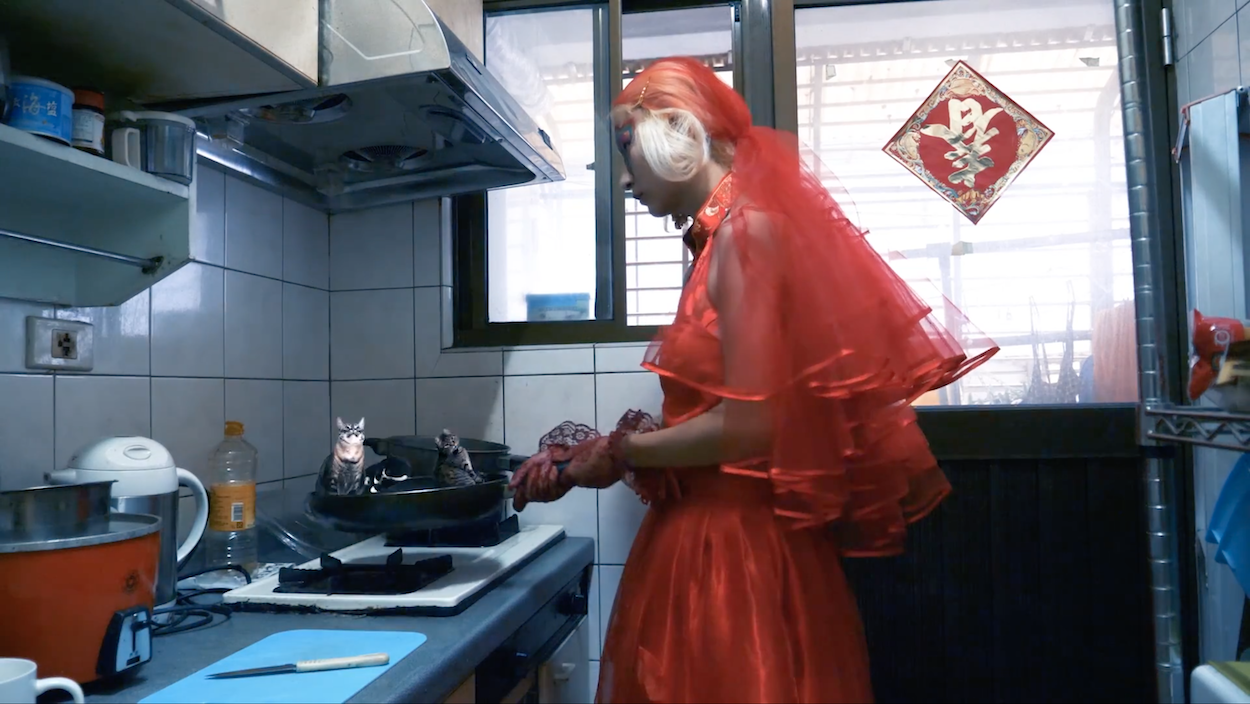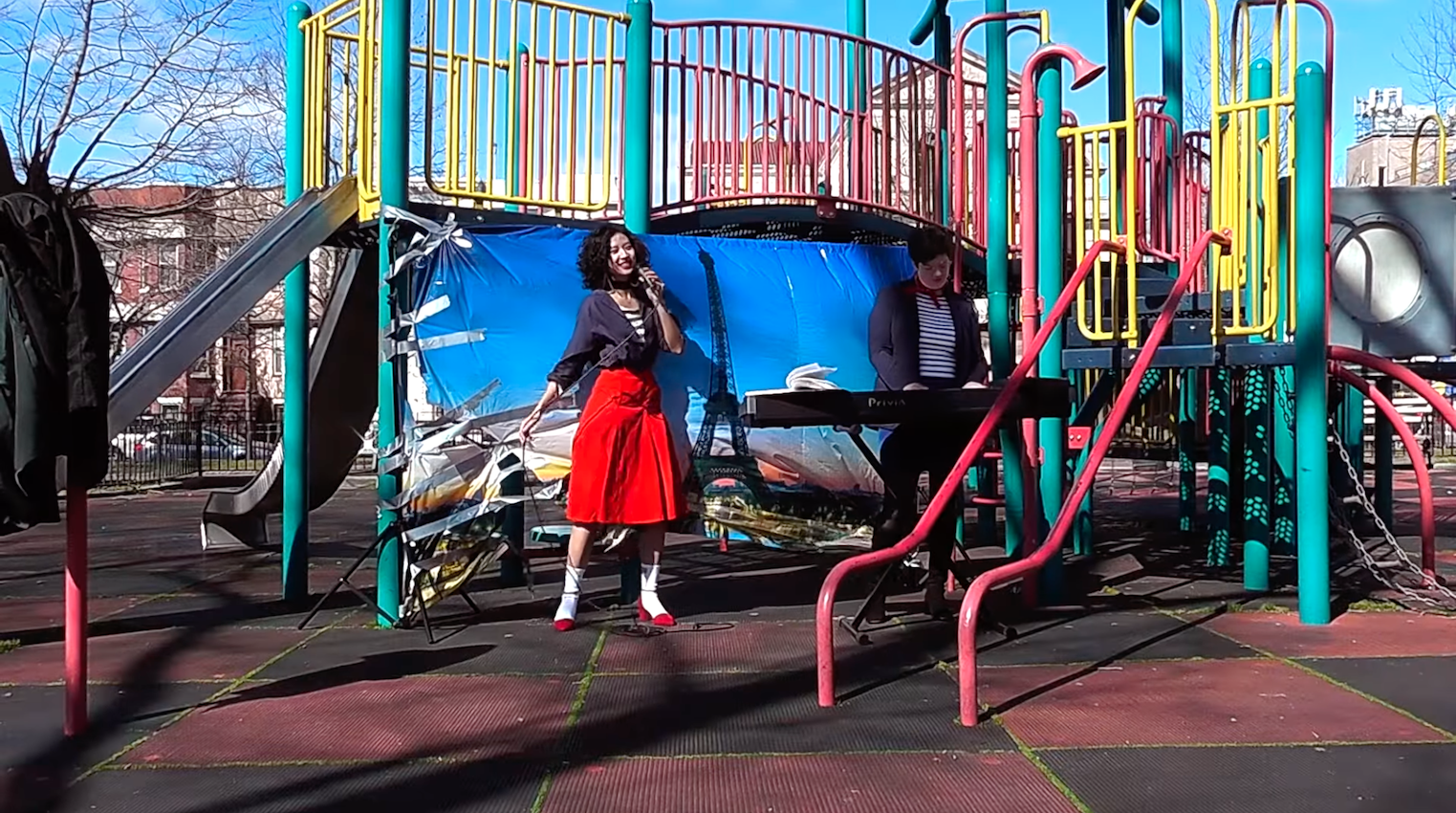by Sheng Kao
語言:
English
Photo credit: Still from 巴黎,我想跟你一起去
SID AND GERI is a Taiwanese visual creator and maker of short films, exploring themes of identity, the body, and the peculiarities of human culture through the mixed mediums of animation, special effects, and live-action skits, often all spliced together into one jarring video. They are arguably more well-known for the music videos they have directed for Taiwanese musicians, the most recent of which being the video for “寶貝好壞 Baby Is So Bad” by Mars Ma (馬念先). Notable Taiwanese pop singer 9m88 collaborated with Sid and Geri as early as 2017, when they released their music video for “Nine Head Ninano” on the artist’s YouTube channel. That year, Sid and Geri also released a short film on their channel starring the pop star, titled “巴黎,我想跟你一起去 Let’s Go To Paris From New York.” These videos make heavy use of special effects and follow no discernible plot, with shots of the musicians dancing and singing cutting away intermittently to randomly-set scenes.
Video for “寶貝好壞 Baby Is So Bad“
The collaborations with 9m88 are easily the most-viewed videos on the Sid and Geri YouTube channel, and it was through these first two videos that I first discovered Sid and Geri. The collaborations are a strange enough introduction to their work, but once I found myself on the Sid and Geri channel page I was inundated with the even more bizarre thumbnails of their other videos. Sid and Geri do produce other types of art, namely short games and toy products, but these YouTube videos constitute the majority of their body of work. A quick survey of their YouTube channel page reveals thumbnail after thumbnail of brightly colored, photoshop collage-type images spliced together, prompting the viewer to click out of pure intrigue.
Clicking on any of the videos immediately immerses the viewer in Sid and Geri’s eccentric filmmaking style, sometimes leaving one with more questions than answers. On the video entitled “J-MAIL x Sid and Geri – 尋愛天使喬吉娜,” which is the channel’s fourth most-viewed video, the top comment reads, “人生要經歷過甚麼才會拍出這種影片[?]” or “What kind of life experiences leads someone to make a film like this?” After binging all of the Sid and Geri YouTube videos in one sitting, and subsequently scrolling through their online store, I was struck with similar questions. After avidly following them on Instagram and YouTube for over a year, I was able to correspond with Sid and Geri over an email interview to learn more about their art practice.
Video for “巴黎,我想跟你一起去 Let’s Go To Paris From New York”
Sid and Geri is the moniker of Yue Mei Lee, who was born in San Francisco in 1991 but raised in Taipei. Their history as an artist began in high school: they attended Fu-Hsin Trade & Arts School (復興商工) in Taipei, where they learned traditional mediums such as oil and watercolor painting. Later on, they attended Shih Chien University, majoring in Fashion Design, of which the artist says “oddly […] was closer to Fine Arts than my high school. It was the first time I felt the liberty to create whatever I want.” After graduating from college, they adopted the name Sid and Geri while deciding to pursue a Master’s degree at the School of Visual Arts in New York City, where they continued to make short films. Since then, their work has been featured in group and solo exhibitions around the world, most notably at the Taiwan Contemporary Culture Lab (C-LAB) in Taipei.
The most prominent elements of Sid and Geri’s distinctive filmmaking style includes non-linear storytelling, absurd humor, and multiple forms of media. What is so interesting and unforgettable about their work is how much meaning can be compressed and expressed in such a short clip; all of their videos are around five minutes or less, with some of the shorter videos at around 30 seconds long. Their use of animation, voiceover, audio clips, and video editing pushes the use of technology in art to its limits, saturating the work with layers of meaning as well as comedic effect, which “serves to further disorient the viewer amidst an already chaotic situation.”
Video for “J-MAIL x Sid and Geri – 尋愛天使喬吉娜“
Non-linear and erratic, Sid and Geri videos utilize variegated sound and visual elements to communicate artistic concepts. They consider sound an inseparable extension of image, the two working together to “propose interactive experiences. Sounds and images become the expression of the distinctive dynamics of the variable behavior that defines the meaning and experience from the work.” This cacophonic method of deploying meaning creates more opportunities for the audience to understand and engage with the different layers found within each video. Viewers are able to “automatically link the screen fragments” in their minds, developing their own individual connections to the work.
In the series of “物語” animal skits, clips of Mandarin or Taiwanese Hokkien dialog (with subtitles in both English and Mandarin) are voiced over animal sculptures, as if the viewer is overhearing a conversation between the creatures. However, the conversations seem as if they could have been overheard between human speakers, whether in a workplace, at a public park, or at a wedding. The snippets of dialog are gossip-like, commenting on inane details such as the arrival of a new coworker or the academic history of a bride. Sid and Geri takes these typically human concerns, especially common in Taiwanese culture, and makes them seem ludicrous and trivial by filtering them through the voices of animals.
Video for “Princess Baby”
Sid and Geri employs a similar concept in “Princess Baby,” in which they portrays the persona of a Taiwanese influencer as a pampered white cat. In this video, the images of the white cat morph into a person wearing items of white clothing, poised like a cat on all fours on a bed, while the voiceover delivers a Mandarin-language monologue heavily spliced with American speech mannerisms. This draws the viewer’s attention to the very human phenomenon of signaling wealth and status, yet exaggerates the coquettishness of the persona so much that they seem grotesque and animal-like. By examining these social interactions through parody, Sid and Geri draw attention to the absurdity of these hierarchies of social signaling.
Sid and Geri also uses the lens of parody to examine aspects of identity such as race or gender; this is especially apparent in the short film “Ms. Walter’s Troubled Mind” and “Amy’s World,” a flash game released in April 2021 as part of the artist’s residency at DE:FORMAL. Their most sophisticated short film, and the most exemplary of their unique filmmaking style, “Ms. Walter’s Troubled Mind” follows the daily life of an Asian woman, who in another interview Sid and Geri reveals is meant to represent as many American stereotypes of East Asia as possible.

Still from “Ms. Walter’s Troubled Mind“
The viewer watches as she engages in a number of domestic rituals such as cleaning, applying makeup, and preparing a Chinese-style fried rice dish while images of Asian wet markets and men in “Beijing bikinis” flash across the screen. As she stir-fries, cat images appear in the pan as she tosses the contents, suggestive of the stereotype that Asians are more willing to eat cats and dogs than other races. In a brief scene, a man at a vegetable market has his skull digitally opened and revealed to be full of Hello Kitties. Interspersed with clips of anti-Asian racism, such as a woman pulling her eyes back to appear narrower, the viewer is left haunted with images of orientalist stereotypes in the same way that the titular Ms. Walter is haunted by her false impressions of Asian people.
The flash game “Amy’s World,” hosted on DE:FORMAL, revolves around a fictional “wife training camp,” where the player’s goal is to “find a wealthy partner and live happily ever after”. The player navigates through rooms of giant purple babies, cheerleaders egging on the player to change their appearance through surgery, and a male character posing with his new Porsche car. With no specific ending—the player is unable to actually achieve any of the stated goals—the game seems more to be about the terrifying experience of confronting these bizarre images and ideals, and not about what happens when these societal goals are actually obtained. In an interview on the DE:FORMAL website, Sid and Geri stated that this game was based on an actual rumor about a Taiwanese American celebrity’s marriage. This exaggeration to the extreme of the importance placed by Taiwanese people on values such as wealth, marriage, and physical appearance questions society’s very investment in them.

Still from “Unfortunate Anchises (浪漫手機)“
Human nature and human bodies are portrayed in grotesque and uncanny ways in Sid and Geri films. Their art is one that is interested in the human mind and body, believing that “you can always find something weird” in a human body or gesture. Sid and Geri’s online shop features numerous body-themed ephemera, whether it’s disembodied heads, naked dolls, or a dog with unnaturally akimbo limbs in keychain or t-shirt form.
Their films “Unfortunate Anchises (浪漫手機)” and “就是愛 Central Park Love” rely on the juxtaposition of bodies and sounds to draw attention to the discomfiting elements of intimacy and love. They also draw attention to the boundaries and similarities between humans and various animals, as seen in the “物語” series, the “Princess Baby” video, and “121 Hour (Night core girl), 2018” video, where images of monkey-fish hybrids swim across the screen as a female voiceover delivers a monologue. By calling attention to the animal-like qualities of humans, Sid and Geri Whether it’s “the tongue movement when kissing or an absurd pose that a human body can do,” Sid and Geri locates both beauty and unease in the human body, inviting viewers to luxuriate in these anxieties and weirdnesses.

Still from “汪汪物語”
Sid and Geri’s modern eye and filmmaking technique is distinctive and resonant; it is no wonder that their polyvalent work has found an audience. Ranging from the universal experience of the body to the specific realities of anti-Asian racism and Taiwanese social pressures, they effectively and humorously communicate the absurdities found in all of these scenarios to their viewers. Aided by numerous music video directing credits, as well as their recent online residency and exhibition at DE:FORMAL, their promising voice has led to a YouTube subscriber count that currently stands at around 7.5k, a growing number indicating that more viewers are attracted to their unconventional art style.



